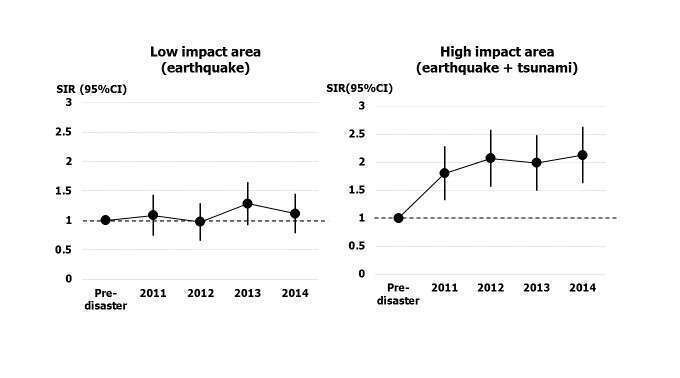
Long-Term Effects of the 2011 Japan Earthquake and Tsunami on Incidence of Fatal and Non-Fatal Myocardial Infarction
2Cardiology, Iwate Ninohe Hospital
3Medicine, Iwate Kamaishi Hospital
4Health Service Center, Iwate University
Objectives: This study aimed to investigate the impact of the 2011 east Japan earthquake and tsunami on the incidence of fatal and non-fatal acute myocardial infarction (MI) in a disaster-affected area over a 4-year period (2011–2014) following the disaster.
Methods: The study employed comprehensive registration of new onset of fatal MI and non-fatal MI. MONICA criteria were used for the case definition for MI, and fatal MI was defined as death within 24 hours of onset of acute symptoms. Severity of tsunami damage in the study area was divided into two zones based on the percentage of submerged area within a residential area (%TFA) (<10% = low-impact area; ≥10% = high-impact area). The standardized incidence ratio (SIR) and 95% confidence interval (CI) for both types of MI during the disaster year (2011) and the following post-disaster years were determined from the number of observed cases relative to the number of expected cases, calculated by age adjusted by incidence for 2 pre-disaster years (2009 and 2010).
Results: During the study period, 1,432 cases of fatal and non-fatal MI were identified. There was no significant difference in scale of the maximum seismic intensity at the acute phase of the disaster between the low- and high-impact areas. In the low-impact area, SIRs for non-fatal MI did not significantly change during a 4 year-period following the disaster or high-impact area. For fatal MI, the SIR was stable during the study period in the low-impact area (Fig., left). However, the SIR for fatal MI in the high-impact area was significantly elevated in the disaster year of 2011 (1.80), and this increase was sustained for the following 3 years (Fig., right). The SIRs for fatal MI for the 4 post disaster years in the municipal areas were significantly correlated with the percentage of the inundated area (r=0.83; p<0.001) and the number of deaths due to the tsunami (r=0.77; p<0.005), but not with the maximum seismic intensity (r=0.43; p=0.12).
Conclusion: These results suggest that the devastating tsunami was associated with a continual rise in the incidence of fatal MI among disaster survivors.


Powered by Eventact EMS